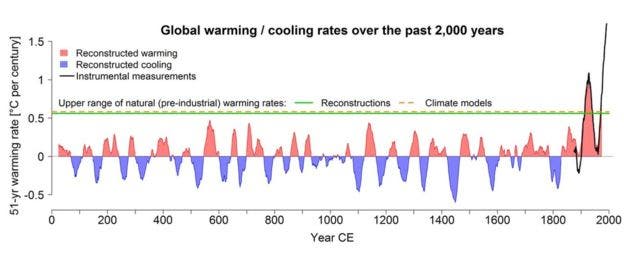Not only is the climate warming faster than at any point in at least 2,000 years, but in contrast to pre-industrial climate fluctuations, climate change is now occurring across the entire planet at the same time.

When it comes to global warming, the general situation is essentially a settled issue. We know that the planet is heating up, and we know that this is happening as a result of our emissions of greenhouse gases (particularly carbon dioxide). However, some details and particularities of this process are not as well understood.
For instance, climate variability over the past 2,000 years has been subject to great debate. As climate change deniers are quick to point out, our planet’s climate has changed before in the past — although this is missing the true scope of the issue. For instance, some might point out that the Earth has been hotter than it is now in its geological past while ignoring the fact that these events happened tens of millions of years ago, due to natural causes, over long periods of time, and the effects were still devastating for life on Earth. The more you look at today’s context, the more you understand that this situation has no precedent.
In a recent study, researchers analyzed the past two millennia, assessing the factors that caused climate variability in the past and the extent of the climatic changes.
In one paper, Raphael Neukom and colleagues from Bern University compiled data from around 700 proxy records of temperature changes. They specifically looked at unusual warming and cooling events. But wherever they looked, they found the same thing: nothing is even close to the current scale of events.
Take an event commonly called the Little Ice Age, a significant cooling event that started in the 1300s and lasted centuries. The period is well-represented in art, with numerous painters covering it through the centuries. This produced an important misunderstanding, researchers say, because it propagated the idea that the entire planet was cooling at the same time.
“It’s true that during the Little Ice Age it was generally colder across the whole world,” explains Raphael Neukom, “but not everywhere at the same time. The peak periods of pre-industrial warm and cold periods occurred at different times in different places.”

According to the study, the cooling events happened mostly in parts of Europe and North America. Because these areas were so influential culturally and artistically, it propagated the idea that the Earth cooled similarly in all parts of the world, which was not really the case — as shown by climate proxies from other parts of the world. For instance, the coldest temperatures occurred in central and eastern Pacific regions in the 15th century, in northwestern Europe and southeastern North America in the 17th century, and elsewhere during the 19th century. This lack of uniformity suggests that local influences, rather than planet-wide phenomena, were at play.
In contrast to that, all of the Earth’s major regions have seen their warmest temperatures in recent years, and the overall trend indicates a constant, planetary warming.
“We find that the warmest period of the past two millennia occurred during the 20th Century for more than 98% of the globe,” the study reads.
“This provides strong evidence that anthropogenic (human induced) global warming is not only unparalleled in terms of absolute temperatures but also unprecedented in spatial consistency within the context of the past 2,000 years.”
The study debunks another misconception: that volcanoes or solar activity are the main drivers of climate change. In pre-industrial times, random fluctuations within the climate systems themselves drove variations and change. External factors such as volcanic eruptions were not intense enough to cause major climate change for decades — let alone centuries.
So what does this tells us? In general principle, nothing new. We knew that the current global warming event is unprecedented in recent history.
However, the two published papers paint a much more complete picture of climate variability over the past two millennia. They offer important constraints and parallels, showing that no period in recent human history is quite like the one we are living in right now. The current warm period is happening across the world for the first time, and it’s unprecedented. There is extremely strong evidence that we are causing it. What we choose to do with that information is up to us.
The results were published in two studies:
- Steiger et al. “No evidence for globally coherent warm and cold periods over the pre-industrial Common Era”. Nature, DOI: 10.1038/s41586-019-1401-2
- PAGES 2k Consortium. “Consistent multidecadal variability in global temperature reconstructions and simulations over the Common Era”. Nature Geoscience, DOI: 10.1038/s41561-019-0400-0


